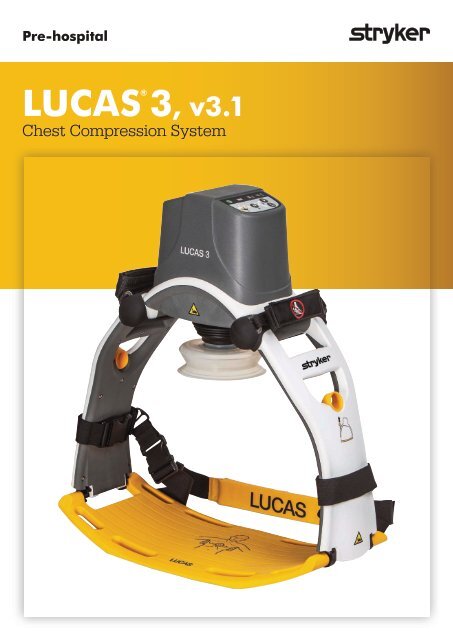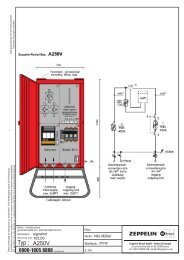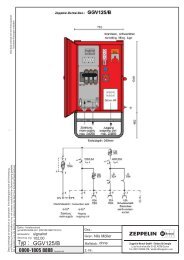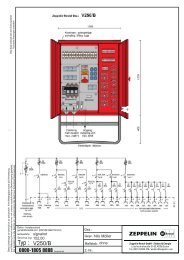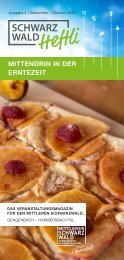LUCAS 3.1 EMS Brocure ENG
You also want an ePaper? Increase the reach of your titles
YUMPU automatically turns print PDFs into web optimized ePapers that Google loves.
Pre-hospital<br />
<strong>LUCAS</strong> 3, v<strong>3.1</strong><br />
Chest Compression System
I AM <strong>LUCAS</strong><br />
The first time people met me was in 2003.<br />
Since that day you can find an astonishing<br />
24,000 of us, across 84 countries.<br />
Cardiac arrests are stressful events.<br />
I AM <strong>LUCAS</strong>. I free up your team members to<br />
perform other lifesaving interventions.<br />
I AM <strong>LUCAS</strong>. I sustain high-quality compressions<br />
wherever CPR is provided at the scene, during patient<br />
movement, in the ambulance or helicopter during<br />
transport, helping keep caregivers safe during transport.
The <strong>LUCAS</strong> Chest Compression system<br />
delivers Guideline-consistent, high-quality<br />
chest compressions which allows you and<br />
your team to work more efficiently and safely.<br />
Safety<br />
Providing manual CPR during patient<br />
transportation is difficult and sometimes<br />
dangerous for the caregiver. It also means<br />
the quality and effectiveness of CPR can be<br />
affected. The <strong>LUCAS</strong> device helps to improve<br />
chest compression quality during patient<br />
movement and transportation. <strong>LUCAS</strong> also<br />
helps reduce the risk of back injuries to the<br />
caregiver compared to manual CPR.<br />
Operational efficiencies<br />
<strong>LUCAS</strong> is your partner in life-support when<br />
every second matters. <strong>LUCAS</strong> helps calm down<br />
the scene by providing an extra pair of hands.<br />
Caregivers can focus on treating underlying<br />
conditions.<br />
Quality of CPR<br />
Delivery of high-quality CPR is vital for patient<br />
outcomes. With its support structure, back plate<br />
and piston with suction cup, <strong>LUCAS</strong> provides<br />
high-quality CPR. <strong>LUCAS</strong> helps to overcome<br />
caregiver fatigue by providing Guidelinesconsistent<br />
CPR for multiple hours if required*.<br />
* When using with multiple batteries or on external power source<br />
Battery typically last for 45 minutes of operation.<br />
<strong>LUCAS</strong> 3, v<strong>3.1</strong> Chest Compression System
<strong>LUCAS</strong> 3, v<strong>3.1</strong><br />
Top window for quick battery check<br />
Usability<br />
The two-step application (back plate, then<br />
upper part) makes it easy and quick to<br />
apply (a median 7 sec. interruption time<br />
at transitioning from manual CPR to<br />
mechanical CPR in clinical use). 1<br />
External power supply<br />
for prolonged operation/<br />
charging<br />
Durable, lightweight carrying case<br />
included with every device
Battery<br />
Wireless connectivity to<br />
LIFENET ® System<br />
Patient straps secure patient arms<br />
during transport<br />
Disposable<br />
suction cup<br />
Adjustable compression rate<br />
Easy to clean stabilisation strap<br />
Standard low profile back plate for quick application<br />
<strong>LUCAS</strong> 3, v<strong>3.1</strong> Chest Compression System
<strong>LUCAS</strong> 3, v<strong>3.1</strong><br />
We continue to innovate the <strong>LUCAS</strong><br />
platform with Wi-Fi ® connection to the<br />
LIFENET ® System.<br />
With the <strong>LUCAS</strong> account in LIFENET,<br />
<strong>LUCAS</strong> 3, v<strong>3.1</strong> allows for tailored rates to meet your<br />
protocols, alerts configured to improve compliance,<br />
Post-Event Reports to your inbox, and asset<br />
notifications by e-mail.<br />
Configure <strong>LUCAS</strong> device via LIFENET<br />
Setup options:<br />
Adjustable rate: 102, 111, 120<br />
compressions per minute – fixed or<br />
variable during operation<br />
Adjustable depth: 45 to 53 ± 2mm<br />
(fixed during operation)<br />
Adjust ventilation alerts, pause<br />
length and count<br />
Auto-lowering of the piston<br />
(AutoFit or QuickFit)<br />
Pressure pad release to allow for<br />
chest rise during ventilation<br />
Audible CPR timer: 1-15 minutes<br />
(in 1 min increments)<br />
Post-Event reporting<br />
• Receive device Post-Event Report (.pdf) via e-mail after device<br />
check-in over Wi-Fi<br />
• Transmit reports wirelessly to any predetermined e-mail<br />
addresses (configurable in LIFENET)<br />
Asset management via LIFENET<br />
• Asset dashboard for fleet status at latest device check-in<br />
• Notifications of expiring and expired <strong>LUCAS</strong> batteries<br />
• Integration with CODE-STAT 11 Data Review Software<br />
Easy-to-read Post-Event Report (.pdf) showing:<br />
• Summary of device use: compression time, ratio, rate, count, number<br />
of pauses > 10 sec. and duration of longest compression pauses<br />
• Visual timeline showing device compressions, rate and pauses<br />
• Event log showing user interactions, battery alerts and alarms<br />
• Full display of device setup for quick reference<br />
• Comprehensive post-event review in CODE-STAT II Data Review<br />
Software (optional)
Specifications<br />
Device and Therapy<br />
Compression rate<br />
• Configurable to 102 – 111 – 120 compressions per minute,<br />
fixed, or variable during use<br />
• Factory default setting: 102 ± 2 compressions per minute<br />
Compression depth<br />
• Configurable to a fixed value between 45 to 53 ± 2 mm<br />
• Factory default setting: 53 ± 2 mm for nominal patients<br />
Note: 40 to 53 mm for chest height < 185 mm<br />
Pressure pad during ventilation<br />
• To allow for chest rise during ventilation the pressure pad<br />
can be configured to move up 10 mm above start position<br />
during pauses or during continuous compressions<br />
• Factory default setting: pressure pad remains in start<br />
position<br />
Compression duty cycle: 50 ± 5%<br />
Compression modes (operator selectable)<br />
• ACTIVE 30:2 mode: 30:2 (factory default setting) or 50:2<br />
(setup option) compression to ventilation ratio<br />
• ACTIVE Continuous mode<br />
Ventilation alerts<br />
• ACTIVE 30:2 mode: LED blinks and audible alert signals<br />
before ventilation pause<br />
• ACTIVE Continuous mode: LED blink. Configurable to 6<br />
to 10 alerts per minute (factory default setting: 10 alerts<br />
per minute). Audible alert configurable ON/OFF (factory<br />
default setting: OFF)<br />
Ventilation pause duration<br />
• ACTIVE 30:2 mode: configurable to 3 to 5 sec. (factory<br />
default setting: 3 sec.)<br />
• ACTIVE Continuous mode: configurable to 0.3 to 2 sec.<br />
(factory default setting: 0.3 sec.)<br />
Suction cup start position<br />
• Configurable:<br />
– QuickFit (factory default setting): Manual lowering of<br />
the suction cup. Automatic fine-tuning will occur when<br />
locking the start position<br />
– AutoFit: Automatic lowering of the suction cup from its<br />
upper position down to the chest<br />
– Manual: Manual lowering of the suction cup to the chest.<br />
No automatic fine-tuning will occur when locking the<br />
start position<br />
Audible timers<br />
• 1 to 15 minutes, in 1 minute increments (factory default<br />
setting: OFF)<br />
• The timer can be setup as either CPR Timer or Continuous<br />
Timer<br />
– CPR Timer: the device only measures the time in<br />
uninterrupted ACTIVE (30:2 or Continuous) modes<br />
– Continuous Timer: the device measures the time<br />
continuously, independent of what mode the device is in<br />
Patients eligible for treatment<br />
• 17.0 to 30.3 cm chest height<br />
• 44.9 cm maximum chest width<br />
• No patient weight limitation<br />
Device post-event data and connectivity<br />
Connectivity<br />
• Wireless connectivity: Device can communicate via<br />
Bluetooth ® (factory default setting ON) and connect to<br />
configured Wi-Fi networks to receive and transmit data<br />
when not in clinical use.<br />
• Local Bluetooth connection for setting up local Wi-Fi<br />
network, and for Post-Event Report generation and<br />
software updates (if Wi-Fi cannot be used)<br />
• Ability to disable Bluetooth and/or Wi-Fi<br />
Wi-Fi and LIFENET capabilities<br />
• Manual or automatic data transmission (configurable):<br />
push the TRANSMIT key in range of known network<br />
(factory default setting), or setup option for automatic<br />
data transmission whenever the device is off, charging<br />
and in range of known network<br />
• Setup options: Device functionality can be configured<br />
with setup options via secure, online platform (LIFENET)<br />
and be transmitted to the device wirelessly. A single setup<br />
profile can be applied to entire fleet or individual setup<br />
options for each device<br />
• Device readiness status: Device can transmit device<br />
readiness and battery notifications wirelessly to any<br />
predetermined e-mail addresses<br />
Device readiness data:<br />
Configurable in LIFENET to send e-mail notifications on<br />
latest device check-in status including:<br />
• Battery nearing expiration<br />
• Battery expired<br />
• Failed device self-test<br />
Device data storage:<br />
4GB (estimated to store more than two uses per day over the<br />
lifetime of the device, 8 years)<br />
<strong>LUCAS</strong> 3, v<strong>3.1</strong> Chest Compression System
Specifications (cont.)<br />
Device physical specifications<br />
Device dimensions when assembled<br />
(HxWxD): 56 x 52 x 24 cm<br />
Device dimensions while stored in carrying case<br />
(HxWxD): 58 x 33 x 26 cm<br />
Battery dimensions (HxWxD): 13.0 x 8.8 x 5.7 cm<br />
Weight of the device with Battery (no straps): 8.0 kg<br />
Battery weight: 0.6 kg<br />
Back plate: Thin and lightweight back plate<br />
(15mm and 1.1 kg)<br />
Device environmental specifications<br />
Operating temperature<br />
• +32°F to +104°F / +0°C to +40°C<br />
• -4°F / -20°C for 1 hour after storage at room temperature<br />
Storage temperature: -4°F to +158°F / -20°C to +70°C<br />
Relative humidity: 5% to 98%, noncondensing<br />
Device IP classification (IEC 60529): IP43<br />
Operating input voltage: 12-28 V DC<br />
Atmospheric pressure: 62-107 kPa /1253 to 13000 ft /<br />
(-382 to 4000 m)<br />
Power specifications<br />
Power source: Proprietary battery alone or with external<br />
power supply or car power cable<br />
Power supply input: 100-240VAC, 50/60Hz, 2.3A, Class II<br />
Power supply output: 24VDC, 4.2A<br />
Car power cable: 12-28VDC/0-10A<br />
Battery type: Rechargeable Lithium-ion Polymer (LiPo)<br />
Battery capacity: 3300 mAh (typical), 86 Wh<br />
Battery voltage (nominal): 25.9 V<br />
Battery run time (nominal patient):<br />
Battery run time 45 minutes (typical), Extended run time<br />
connecting to external power supply<br />
Maximum Battery charge time:<br />
Charged in the device using external power supply:<br />
• Less than two hours at room temperature (+72°F / +22°C)<br />
Charged in the external battery charger:<br />
• Less than four hours at room temperature (+72°F / +22°C)<br />
Battery service life (interval for recommended<br />
replacement)<br />
• Recommendation to replace the battery every 3 to 4 years<br />
or after 200 uses (of more than 10 minutes each time)<br />
• End of Battery service life will be indicated by a constant<br />
yellow LED to the far right on the Battery charge indicator<br />
Battery IP classification (IEC 60529): IP44<br />
Battery charge temperature<br />
• +32°F to +104°F / +0°C to +40°C<br />
• (+68ºF to +77ºF / +20ºC to +25ºC preferred)<br />
Battery storage temperature<br />
• -4ºF to +104ºF / -20ºC to +40ºC<br />
• +105ºF to +158ºF / +41ºC to +70ºC<br />
ambient for less than a month<br />
Reference:<br />
1. Levy M, Yost D, Walker R, et al. A quality improvement initiative to optimize use of a mechanical chest compression device within a high<br />
performance CPR approach to out-of-hospital cardiac arrest. Resuscitation. 2015;92:32-37.<br />
Medical<br />
2460<br />
This document is intended solely for the use of healthcare professionals. A healthcare professional must always rely on his or her own<br />
professional clinical judgment when deciding whether to use a particular product when treating a particular patient. Stryker does not dispense<br />
medical advice and recommends that healthcare professionals be trained in the use of any particular product before using it in surgery.<br />
The information presented is intended to demonstrate the breadth of Stryker product offerings. A healthcare professional must always refer to the<br />
package insert, product label and/or instructions for use before using any Stryker product. Products may not be available in all markets because<br />
product availability is subject to the regulatory and/or medical practices in individual markets. Please contact your Stryker representative if you<br />
have questions about the availability of Stryker products in your area.<br />
Stryker Corporation or its divisions or other corporate affiliated entities own, use or have applied for the following trademarks or service marks:<br />
LIFENET, <strong>LUCAS</strong>, Physio-Control, Stryker. All other trademarks are trademarks of their respective owners or holders. The products depicted are<br />
CE marked in accordance with applicable EU Regulations and Directives. This material is not intended for distribution outside the EU and EFTA.<br />
Manufactured by:<br />
Jolife AB<br />
Scheelevägen 17,<br />
Ideon Science Park,<br />
SE-223 70 LUND, Sweden<br />
www.lucas-cpr.com<br />
©2018 Physio-Control, Inc.<br />
GDR 3336900_A


